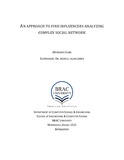An approach to find influencers analyzing complex social network

View/
Date
2017-07Publisher
BARC UniversityAuthor
Chaki, DipankarMetadata
Show full item recordAbstract
Popularity of social media in Bangladesh is prodigious. 80 percent of internet users are on social networking websites like Facebook, Twitter. That is over 16 million people and counting. The rate of new Facebook users is outpacing the country’s birth rate as one new Bangladeshi Facebook account is opened every 20 seconds. This makes social media a great platform for government to reach out to citizens and stay up-to-date with current events and trends in society. That is why, a Facebook group named “Public Service Innovation Bangladesh” has been created. In this group, discussions related to public service innovation, public service related problems and solutions, decision making in administrative works etc. are being prioritized. The focus of this study is to construct complex network from posts given by the members of this Facebook group, analyze features of the complex network including degree distribution, assortative mixing and betweenness centrality. It is important to detect influencers of that Facebook group. We have analyzed group data from January 1, 2016 to June 30, 2017 and generated a report which has given some interesting insights about that group. During this time frame, 5183 posts have been posted and most amazingly, majority of these posts have been posted from November, 2016 to till date. So, it can be said that, this group is growing now. In our constructed network, we have seen that the people who give more posts, get more likes and comments. That is how, they tend to be connected with other highly connected people. If a person who has many connections, gives a post, gets more attention meaning likes and comments than other. Our study helps to understand the structure of this group and finds the influencers of the group.
Index Terms: Complex Network Analysis, Social Network Analysis, Betweenness Centrality, Closeness Centrality, Degree Centrality, Characteristics Path Length
